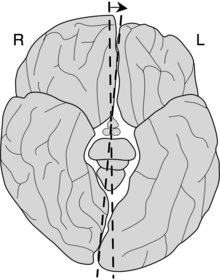Lateralization of the brain
The neuroanatomical inequality and functional division of tasks and specialization of the cerebral hemispheres is called lateralization of the brain . The brain of most higher organisms is morphologically considered bilaterally established. Although this symmetry indicates a substantially similar structure, it has long been known from various observations and experiments that the tasks and functions of the brain have experienced a spatial specialization. Some functions or partial functions of the brain are preferably carried out in one of the two halves of the brain. The division of processes into the right and left halves is called lateralization .
The cerebrum consists of two heavily furrowed hemispheres, which are separated from one another by a deep incision - the longitudinal cerebral fissure (fissura longitudinalis) . The connection between the two hemispheres is made by a thick nerve cord called the corpus callosum .
Anatomical asymmetries
Anatomical asymmetries of the hemispheres are macroscopically or microscopically detectable differences between corresponding structures in both halves of the brain. Macroscopically, differences in the volumes of circumscribed brain areas and in the length, depth and shape of brain furrows can be determined. A microscopic examination shows that there are differences in terms of the occurrence of individual cell types and their interconnectedness.
The most important asymmetries concern the Sylvian furrow , the planum temporale , the Heschl gyrus , the sulcus centralis and the occipital and frontal width. In 70% of the cases it can be demonstrated that the Sylvian furrow is more extensive in the left hemisphere. This is especially true for right-handers. In addition, the left hemisphere has a larger specific total weight, a larger insular cortex, a larger proportion of gray matter, a larger inferior temporal lobe and the posterior lateral nucleus of the thalamus . Ultimately, the left frontal lobe is narrower.
Functional asymmetries
Methods
Early studies on the functional specialization of the hemispheres are largely based on neurological and neuropsychological studies on the effects of brain injuries (lesions) on cognitive abilities . By comparing two patients with lesions in different hemispheres, conclusions can be drawn about the functional lateralization based on the principle of double dissociation .
Since the 1960s, the connection between the hemispheres was surgically removed in split-brain patients , which enabled an experimental study of the workings of the hemispheres of the brain. Hemispheres can also be reversibly blocked with the help of the Wada test .
Due to the ethical problems involved in human trials, surgical interventions were often justified by the simultaneous, sometimes successful, treatment of epileptics. Due to technical progress, imaging methods such as magnetic resonance tomography have gained increasing importance in the last few decades .
Lateralization of cognitive skills
The best-known example of functional asymmetry is the dominance of the left hemisphere in speech production , which can be demonstrated in around 95% of right-handers and 70% of left-handers. Studies in split-brain patients have shown that a stimulus processed only in the right hemisphere does not allow any linguistic expressive utterances. Furthermore, the left hemisphere of the brain is considered to be dominant in word recognition and mathematical operations. Dominance of the right hemisphere can be demonstrated, among other things, in spatial perception and face recognition.
Right shift theory
According to the right-shift theory developed by Annett, the dominance of language in the left hemisphere is due to a single gene. This influence would not only be linked to an inhibition of the corresponding development in the right hemisphere, but would also disadvantage the motor dexterity of the left hand as a side effect and thus explain the connection between handedness and hemispheric specialization. According to Annett, an extremely pronounced hemispheric dominance also implies disadvantages in cognitive or motor performance. The right-shift theory is controversial in contemporary research, for example Crow and co-workers could not find a connection between extreme hemispheric dominance and cognitive impairment.
See also
literature
- Tobias Hürter: Personality: I am two . In: The time . No. 25, June 13, 2013
- Hans-Otto Karnath and Peter Thier (eds.): Neuropsychology. 2nd updated and expanded edition. Springer, Heidelberg 2006, ISBN 3-540-28448-6
- Bryan Kolb and Ian Q. Whishaw: Neuropsychology. Spectrum Academic Publishing House, Heidelberg / Berlin / Oxford 1996, ISBN 3-8274-0052-X
- Sally P. Springer and Georg Deutsch: Left - Right Brain. 4th edition. Spectrum Academic Publishing House, Heidelberg / Berlin 1998, ISBN 3-8274-0366-9
Web links
- Lateralization - small article including comparison of left and right lateralization
Individual evidence
- ^ Article "Lateralisierung", in: Lexikon der Neuroswissenschaften , Heidelberg, Spektrum Akademischer Verlag, 2001, ISBN 3-8274-0453-3 Volume 2, p. 290.
- ^ "Laterality" in: W. Arnold, J. Eysenck, R. Meitli: Lexikon der Psychologie, Vol. 2. Herder Verlag Freiburg, Basel, Vienna 1971; P. 406; ISBN 3-451-16112-5 .
- ↑ in Steven Pinker: Sprachinstinkt, Munich 1998, p. 351 ff, explained there under symmetry.
- ↑ Wolfgang Hartje, Klaus Poeck (Ed.): Clinical Neuropsychology. Thieme, Stuttgart 2000, ISBN 3-13-624506-7 , p. 91.
- ^ Rainer Schandry : Biological Psychology. BeltzPVU Weinheim, 2003, ISBN 3-621-27590-8 .
- ↑ Wolfgang Hartje, Klaus Poeck (Ed.): Clinical Neuropsychology. Thieme, Stuttgart 2000, ISBN 3-13-624506-7 , pp. 85f.
- ↑ Article “Asymmetry of the Brain”, in: Lexikon der Neuroswissenschaften , Heidelberg, Spektrum Akademischer Verlag, 2001, ISBN 3-8274-0453-3 Volume 1, p. 114.
- ↑ see: Eric Heinz Lenneberg .
- ^ Annett: "Annotation: Laterality and Cerebral Dominance", in: Journal of Child Psychology and Psychiatry , 1991.
- ^ TJ Crow, LR Crow, DJ Done, S Leask: “Relative hand skill predicts academic ability: global deficits at the point of hemispheric indecision”, in: Neuropsychologia , 1998.
